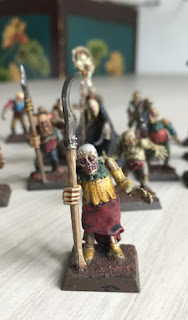The early '90s are my favourite period in Mithril production and this piece clearly confirms the rule: it is just lovely. Sculpted of course by C. Tubb, it is part of the Isengard range. The figure conveys perfectly the characteristics of the character from the book, Gríma Wormtongue:
"At his feet upon the steps sat a wizened figure of a man, with a pale wise face and heavy-lidded eyes."
"He looked at them with half-closed eyes. Last of all he scanned Théoden's face and opened his mouth as if to speak. Then suddenly he drew himself up. His hands worked. His eyes glittered. Such malice was in them that men stepped back from him. He bared his teeth; and then with a hissing breath he spat before the king's feet, and darting to one side, he fled down the stair."
TT, The King of the Golden Hall
Wormtongue is short, slightly hunched, working his hands and looking with half-closed eyes in front of him, ever calculating, ever playing his words like cards in a game. Dressed in rich garb, he looks far from noble - quite the opposite.
To do the miniature justice, I painted it in pastel colours drawing inspiration from High Middle Ages miniatures. His robe of sea green is trimmed in silver and he wears a shirt of dark purple, light purple trousers and gaiters of nice yellow leather. He is, of course, pale and blonde, like most of the Rohirrim.
Yes, blonde. It doesn't say anywhere that he was dark haired. People just picture him dark haired because he's evil.
 |
| Ralph Bakshi's version |
 |
| Brothers Hildebrandt |
 |
| John Howe |
 |
| Peter Jackson's version |
Seriously, what's up with him? If he's the only raven-haired person, dressed all in black, among a golden-haired people dressing in green and white, how did they not figure out he was evil? So much for subtlety XD

















































